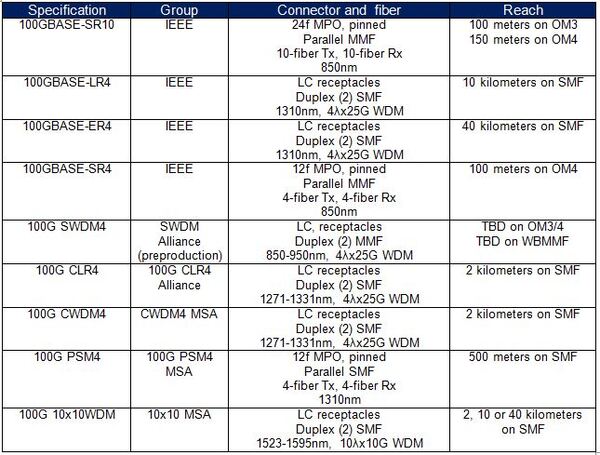The most recent quarterly earnings report from Finisar indicates that 100 Gigabit Ethernet (100GE) is starting to reach its prime time in the data center. I have also heard that choosing the right 100GE optical transceiver can be like navigating through a maze. Even though adoption is happening, it appears there is still confusion about what the options are. Let’s talk about some of the characteristics of optical transceivers to help you get out of the maze.
An optical transceiver is a photonic and electronic device that transmits and receives signals over optical fiber. The complexity of a 100GE optical transceiver relates to two of its aspects: specification and form factor.
Specification
There are many different specifications in the market that define 100GE optical transceivers today. These specifications are either developed by a standards body like IEEE or by an industry consortium under multisource agreement (MSA). The following table lists the names of leading 100GE optical transceivers with their key characteristics.
Optical transceivers under different specifications do not interoperate with each other. For example, although capable of interoperation, a 100G CLR4 transceiver doesn’t interoperate by default with a 100G CWDM4 transceiver – even though they are alike. Additionally, the data rate of 100 Gb/s can be delivered over fiber using two mechanisms:
- Duplex: 100 Gb/s is transmitted over one fiber and received over another fiber at the same time.
- Parallel: 100Gb/s is allocated over a set of multiple fibers (say, four) for transmitting and another set of fibers (four) for receiving.
The discussions around the pros and cons of the different 100GE transceiver specifications—and the two different delivery mechanisms—are beyond the scope of this post. It requires a comprehensive evaluation based on costs, cable reach, performance, future proofing and more. Ultimately, it will be up to the market to choose which standard(s) dominates.
Form Factor
Besides the specifications, the form factor of optical transceivers adds the second aspect of complexity. 100GE optical transceivers can be made with different form factors for their pluggable modules. The 100GE transceiver started with the CFP and CXP form factors. Later CFP2, CFP4 and QSFP28 versions came to the market.
Different form factors represent variations in size and power (heat) dissipation capability. Transceiver form factors determine the network port density on the switch’s line cards. Network port density is an important consideration for users. It appears that the market prefers the QSFP28 as the primary form factor for the 100GE transceiver.
The combination of different specifications and form factors of transceiver modules increases the complexity of choosing the right 100GE transceiver for your needs. Hopefully I have helped clarify the “maze” a little bit for you. Should you like to know more about optical transceivers for 10/25/40/100/200/400GE, please check out the optical transceiver reference guide. You can also view the eBook, The Connected and Efficient Data Center, for more information. And leave me a comment with any questions.
Note:
- SMF = Single-mode fiber
- MMF = Multimode fiber
- WBMMF = Wideband Multimode Fiber
- SWDM = Shortwave Wavelength Division Multiplexing
- CWDM = Coarse Wavelength Division Multiplexing
- WDM = Wavelength Division Multiplexing








